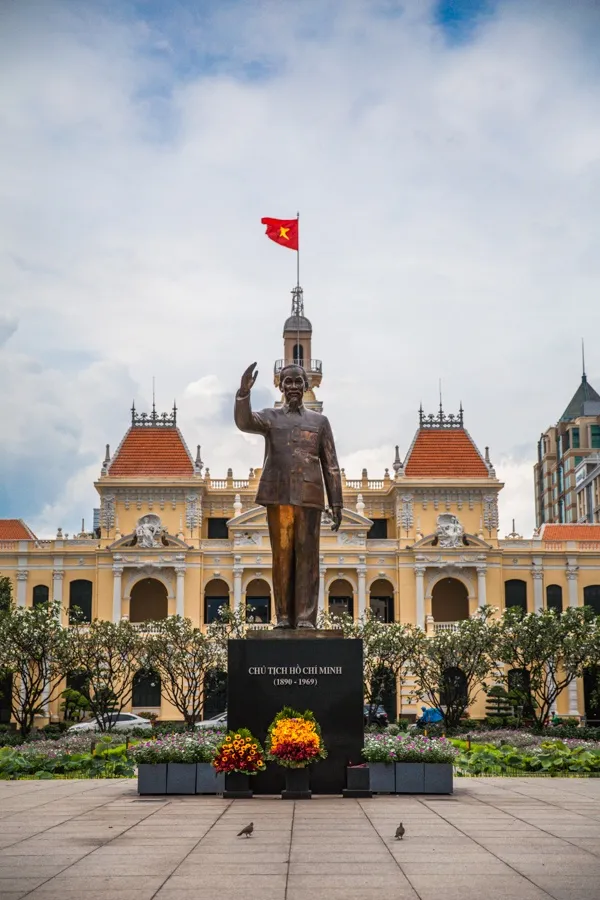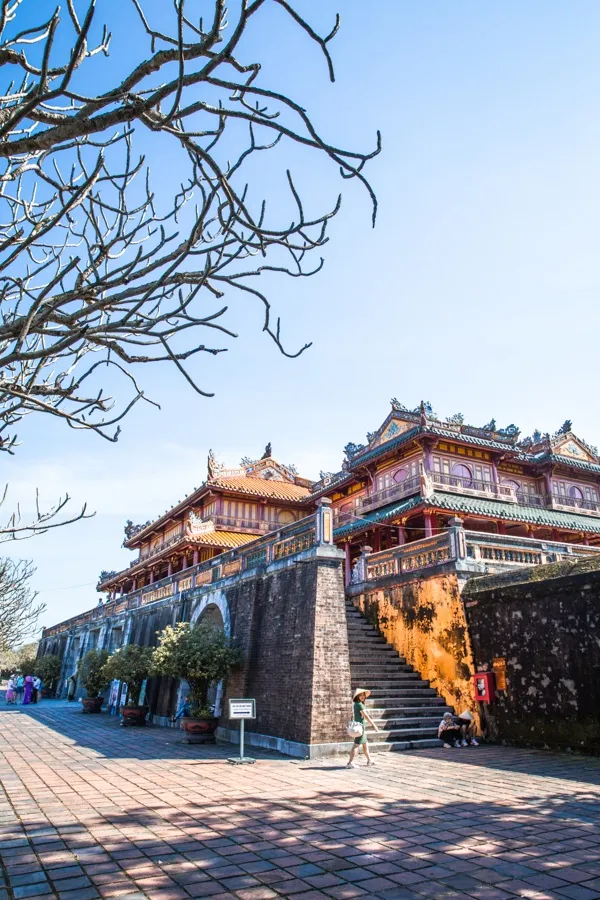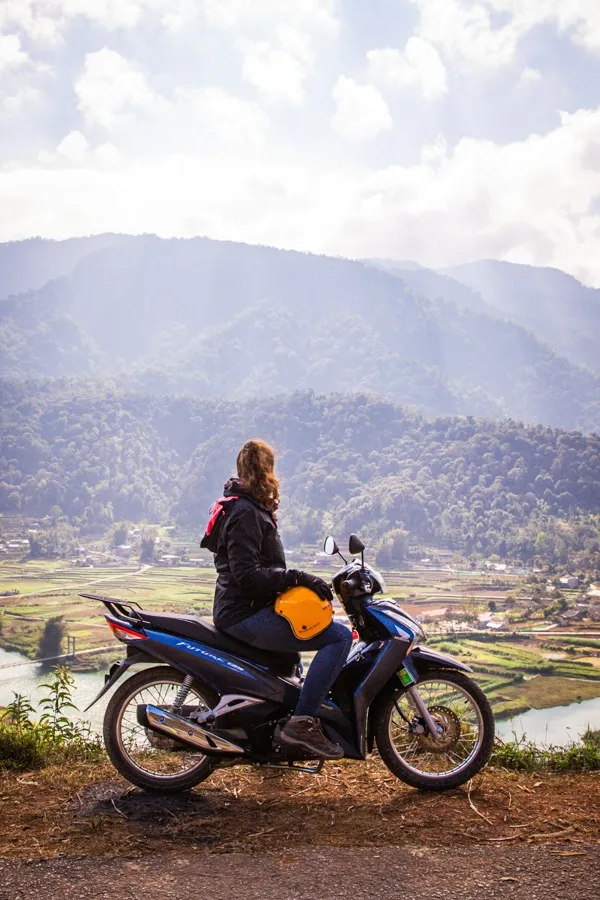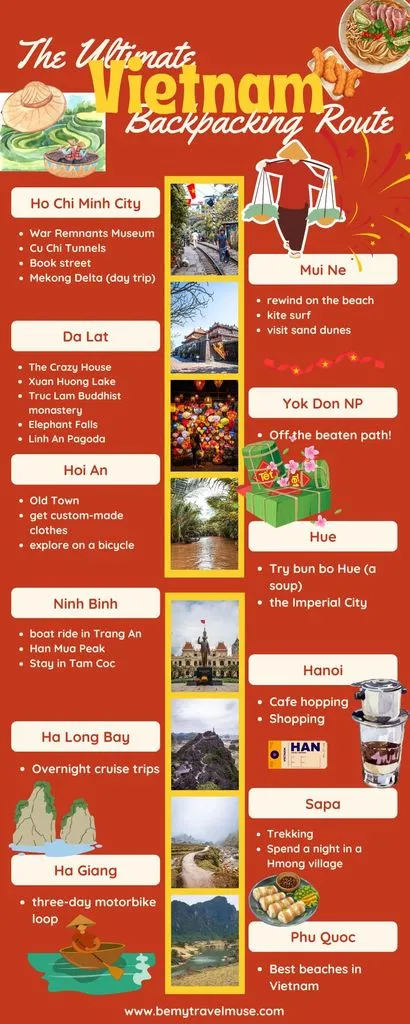Vietnam is an absolute must-visit for many adventurers exploring Southeast Asia. If you’re seeking a destination where your travel budget stretches incredibly far, boasting a vibrant history, and offering effortless access to breathtaking landscapes – from lush jungles and pristine beaches to dramatic mountains – then embarking on a Vietnam backpacking trip is an exceptional choice.
Beyond its natural beauty and affordability, Vietnam holds a special place in the hearts of travelers for its culinary wonders. Witnessing the evolution of cuisine from region to region is fascinating, yet the consistent thread is how incredibly cheap, flavorful, and often healthy the food remains across the country. This guide outlines many of the best spots, following a popular south-to-north route, easily reversed if you’re traveling the other way.
Kickstarting Your Vietnam Backpacking Trip in Ho Chi Minh City
Formerly known as Saigon, Ho Chi Minh City is a frequent starting point for a Vietnam backpacking trip. This energetic metropolis was my first introduction to the country’s famously delicious food scene. A mandatory culinary experience here is trying banh mi, a unique and flavorful sandwich believed to have originated in this very city.
One of the most compelling aspects of HCMC is the opportunity to delve deep into Vietnam’s history. Essential stops include the War Remnants Museum and the Cu Chi Tunnels, offering poignant insights into the Vietnam War (known locally as “the American War”).
Apart from its historical significance, Ho Chi Minh City is also adorned with beautiful remnants of French colonial architecture. For those who love to read, make sure to wander down Book Street, an entire thoroughfare lined with charming bookstores.
 Ho Chi Minh City street life during a Vietnam backpacking trip
Ho Chi Minh City street life during a Vietnam backpacking trip
Exploring the Serene Mekong Delta
Located just south of Ho Chi Minh City, the Mekong Delta is often visited on a day trip, although I chose to spend a couple of days in Can Tho city to truly immerse myself in the region. There is indeed a wealth of experiences waiting in this area.
The Mekong, Southeast Asia’s longest river, nourishes a truly picturesque region. You can glide through the waterways on a boat cruise, witness the vibrant activity of floating markets, explore tranquil small villages, and savor delicious local specialties found along the riverbanks.
Fun Things to Do in Kissimmee Florida
Where To Go In Waikiki – Your Ultimate Guide to Hawaii’s Iconic Beachfront
The Best Things to Do in Naples – Your Ultimate Italian Experience
One of my most cherished memories in the Mekong Delta was cycling through the surrounding villages and vast rice fields. This peaceful, rural region provides a stark and wonderful contrast to the non-stop energy of HCMC, offering a glimpse into a different pace of Vietnamese life during your Vietnam backpacking trip.
Coastal Calm in Mui Ne
Mui Ne presents itself as a more upscale beach destination, characterized by its array of oceanfront resorts. It’s particularly favored by kitesurfers drawn to its breezy conditions and is also famous for its striking red and white sand dunes, perfect for some playful exploration.
This resort town generally offers a more relaxed atmosphere compared to places like Nha Trang. If your Vietnam backpacking trip itinerary includes a desire for a tranquil spot to unwind by the coast, Mui Ne stands out as one of the nicer beach areas you can choose.
Discovering the Charm of Da Lat
Beautifully unique and undeniably quirky, Da Lat is a destination where you’re likely to encounter more Vietnamese tourists than Western ones. Its popularity as a local getaway contributes significantly to its cool and authentic vibe, making it a fascinating stop on a Vietnam backpacking trip.
Highlights include the wonderfully eccentric Crazy House, designed by an architect inspired by Gaudi. Strolling beside the serene Xuan Huong Lake is a pleasant pastime. Day trips to the peaceful Truc Lam Buddhist monastery, the powerful Elephant Falls, and the ornate Linh An Pagoda offer great excursions into the surrounding nature and spirituality. I rented a scooter here to explore the countryside for a day; despite getting caught in a downpour, the experience was absolutely memorable.
The Beach Scene in Nha Trang
Nha Trang is another well-known beach destination along the Vietnamese coast. However, it’s often associated with a more pronounced party atmosphere compared to other seaside spots. While there are some decent beaches in and around Nha Trang itself, I personally found it to be quite tourist-centric and somewhat less appealing than the quieter charm of Mui Ne or the cultural richness near Hoi An during my Vietnam backpacking trip. It caters to a specific kind of traveler.
Seeking Solitude in Yok Don National Park
I stumbled upon Yok Don National Park primarily driven by a desire to find a place in Vietnam that felt truly untouched and off the conventional backpacker trail. I can confidently say that Yok Don fulfills this requirement, receiving remarkably few international visitors each year.
Getting to Yok Don can be a bit challenging, requiring some planning and potentially patience. However, once you arrive, you are rewarded with genuine peace and solitude, a welcome respite from the bustling backpacker crowds you might encounter elsewhere on your Vietnam backpacking trip. It’s a place for nature lovers seeking quiet immersion.
Falling for the Magic of Hoi An
Hoi An quickly became one of my favorite cities in Vietnam. Its ancient streets are famously adorned with thousands of vibrant, colorful lanterns, creating an incredibly picturesque and tranquil atmosphere, especially in the evenings. It’s a town that truly captivates.
Beyond simply exploring the enchanting Old Town and visiting its historic Chinese temples, Hoi An is renowned globally for its tailoring. A highlight for many travelers is getting custom-made clothing and accessories. Hundreds of talented tailor shops line the streets, ready to craft almost anything imaginable from scratch, offering a unique shopping experience on your Vietnam backpacking trip. Another joy here was renting a bicycle and effortlessly exploring the flat surroundings. The beach is conveniently located just about a mile or two from the city center, making it an easy cycle trip.
Stepping Back in Time in Hue
Hue primarily found its way onto my itinerary because I was specifically eager to try bun bo Hue, the city’s famous spicy beef noodle soup. What I discovered upon arrival was a quiet, reflective city steeped in ancient history, possessing an almost haunting quality due to its past.
This city is most famous for being home to the Imperial City, a vast walled complex constructed in 1803. It served as the capital of Vietnam under the Nguyen dynasty. The site is extensive and full of historical significance. If you consider yourself a history enthusiast, Hue is an absolutely essential stop on your Vietnam backpacking trip and a place you simply cannot afford to miss.
 Imperial City complex in Hue, Vietnam
Imperial City complex in Hue, Vietnam
Nature’s Paradise in Phong Nha
While Hoi An charmed me as my favorite city, Phong Nha captured my heart as my favorite natural area in Vietnam. The landscape here is utterly dreamy, characterized by undulating, unique karst rock formations rising majestically from the earth, surrounded by idyllic, lush rice paddies stretching as far as the eye can see.
Adding to the appeal are numerous stunning caves, many offering opportunities for exploration and even swimming. The local people in Phong Nha were exceptionally friendly and welcoming, often flashing peace signs and warm smiles. It truly felt like a little slice of paradise, slightly less visited by the main backpacker crowds, which makes a positive difference. If nature and adventure call to you on your Vietnam backpacking trip, definitely make time for this national park, rent a motorbike for a few days, and embark on your own explorations.
The Scenic Beauty of Ninh Binh
Situated just a couple of hours south of Hanoi, the province of Ninh Binh is primarily celebrated for its breathtaking natural beauty, often referred to as ‘Ha Long Bay on land’. Key activities here include taking a serene boat ride through the karst landscapes of Trang An or Tam Coc, climbing to the top of Hang Mua Peak for panoramic views, and cycling through the picturesque countryside dotted with limestone formations and rice fields.
It’s a useful tip for travelers planning a Vietnam backpacking trip that most choose to stay in the small town of Tam Coc rather than the city of Ninh Binh itself, which is generally considered less appealing. After comparing both locations during my visit, I can confirm that Tam Coc offers a much more pleasant base for exploring the region’s natural wonders.
 Hang Mua Peak in Ninh Binh, a highlight of a Vietnam backpacking trip
Hang Mua Peak in Ninh Binh, a highlight of a Vietnam backpacking trip
The Bustling Capital: Hanoi
Hanoi stands out as one of my favorite Asian capital cities, partly due to its charming, cozy cafés and diverse restaurants. Café Giang, for instance, is globally famous for its unique egg coffee, a local specialty. While I must admit it wasn’t my personal favorite, countless visitors adore it, making it a must-try experience when you’re in town during your Vietnam backpacking trip.
Hanoi is also renowned for its excellent shopping opportunities, ranging from high-end boutiques to bustling traditional markets scattered throughout the city. The city presents a fascinating blend of East and West influences; the French colonial era has left a lasting mark visible in the quaint, tree-lined streets and elegant colonial buildings that contrast with traditional Asian architecture. Furthermore, Hanoi serves as the key gateway to the magnificent northern destinations of Ha Long Bay and Sapa, two places that are practically essential additions to any comprehensive Vietnam backpacking trip itinerary.
The Iconic Beauty of Ha Long Bay
Everywhere you turn in Hanoi, you’re bound to see advertisements for 2- or 3-day trips to Ha Long Bay. This UNESCO World Heritage site is famous for its truly magical landscape: thousands of towering limestone karsts dramatically rising directly out of the emerald waters. These trips typically involve at least one night spent aboard a boat and often include a stay on an island, with options varying widely in terms of luxury and price point to suit any budget on a Vietnam backpacking trip.
For those seeking a more social scene, the Oasis Bay Party Cruise is a popular choice, allowing you to explore the stunning bay during the day and enjoy lively parties at night. If a higher-end experience is more your style, it’s best to visit several tour operators in Hanoi, compare packages and prices, and negotiate to find the tour that best matches your preferences and budget for exploring this iconic destination.
 Beautiful karst landscape of Ha Long Bay on a Vietnam backpacking trip
Beautiful karst landscape of Ha Long Bay on a Vietnam backpacking trip
Trekking Through the Terraces of Sapa
Spending a night in a traditional Hmong village and trekking through the stunning landscapes of Sapa is arguably a quintessential experience on any Vietnam backpacking trip. It offers a unique opportunity for genuine local immersion and provides access to some of the most breathtaking rice paddies and mountain scenery in the country.
Beyond the Hmong people, Sapa is home to several other distinct ethnic minority groups, including the Red Dao, Tay, Giay, and Xa Pho. Each group boasts its own rich culture, traditions, and vibrant textiles, making cultural encounters here incredibly interesting and insightful. I took an overnight bus from Hanoi with a friend and rented a scooter in Sapa for a couple of days to explore independently.
We went on hikes and visited Hmong villages, though we weren’t lucky with the January weather and ended up quite soaked! However, if you visit during the harvest season (typically September to early October), the weather is generally much better, and you’ll be rewarded with the sight of stunning golden rice fields ready for harvest. Many travelers also opt for guided tours of Sapa, which often include organized hikes and homestays for a more structured cultural experience.
The Grand Adventure of the Ha Giang Loop
The city of Ha Giang serves as the starting point for the famous eponymous three-day motorbike loop. Located in the far north of Vietnam, close to the border with China, this region offers arguably the most mesmerizing landscapes in the entire country. With its dramatic mountain passes, deep valleys, winding rivers, traditional mountain villages, and incredibly friendly locals, this part of Vietnam is nothing short of spectacular for an adventurous Vietnam backpacking trip.
If you don’t feel comfortable riding a motorbike yourself (the loop involves challenging mountain roads), a popular and highly recommended alternative is to hire a local guide, known as an “easyrider.” They are experienced riders who will take you on the back of their bike, allowing you to fully soak in the breathtaking scenery and navigate the challenging terrain safely while learning from a local.
 Ha Giang Loop motorbike adventure in Northern Vietnam
Ha Giang Loop motorbike adventure in Northern Vietnam
Extra: The Island Escape of Phu Quoc
Phu Quoc is a large island situated off the southern coast of Vietnam, geographically closer to Cambodia. As I haven’t had the chance to visit it myself, I cannot wholeheartedly recommend it based on personal experience for a Vietnam backpacking trip.
However, I wanted to include it here because it’s widely reported to be incredibly laid-back and is often said to boast some of the absolute best beaches in all of Vietnam. Given its proximity to Cambodia and the renowned beauty of that country’s coastline, it stands to reason that Phu Quoc would offer similar tropical appeal. If your itinerary allows for extra time and you prioritize beach relaxation, consider adding Phu Quoc. (And if you do, please return and share your experience!).
Essential Transport Tips for Your Vietnam Backpacking Trip
Navigating Vietnam as a backpacker is relatively straightforward, thanks to well-established routes and transport options. Most tourists will require a visa to enter Vietnam. For citizens of countries like the United States and many others, the most convenient method is often obtaining an e-visa. The cost is typically $25 USD for a single entry or $50 USD for a multiple-entry visa, making the entry process quite accessible.
There are several popular and easy ways to travel between destinations during your Vietnam backpacking trip:
- Buses: I primarily utilized buses for getting around Vietnam. They are generally quite comfortable, especially the sleeper buses used for longer or overnight journeys, which often provide a snack and offer flat beds. Buses can also be easier to book on short notice compared to trains, particularly during peak travel times like Lunar New Year (Tet).
- Trains: This is arguably the most classic and popular method for traveling up or down the length of Vietnam. Trains are also comfortable and offer scenic views, but booking well in advance is crucial, especially if your Vietnam backpacking trip coincides with major holidays like Lunar New Year, as tickets sell out quickly.
- Motorbike: A truly adventurous option is to buy a motorbike and ride it the entire length of the country, either from north to south or vice versa. The obvious upsides include incredible freedom, the ability to stop anywhere, and an undeniable sense of adventure. You are guaranteed to accumulate more than a few good stories from such an undertaking. However, it’s crucial to be aware of the potential downsides: you should anticipate spending time dealing with mechanics for repairs and there is a significant risk of accidents on Vietnam’s sometimes chaotic roads. Some travelers decide the challenges are too great and sell their bikes partway through; you might get lucky and find a used bike for sale in a city like Hoi An, roughly in the middle of the country.
- Taxis: Within cities, taxis can be a useful option, provided you use reputable companies. To avoid potential scams or overcharging, I highly recommend using ride-hailing apps like Grab. Grab functions much like Uber and allows you to book either a car or, more commonly and cheaply for solo travelers, a motorbike ride.
 Vietnam backpacking trip itinerary map
Vietnam backpacking trip itinerary map
A Vietnam backpacking trip is an adventure packed with diverse experiences, delicious food, rich history, and stunning natural beauty. With the relative ease of getting around and the country’s affordability for visitors, it truly is a brilliant choice for anyone backpacking across Southeast Asia, offering immense value and unforgettable memories.
FAQ About Your Vietnam Backpacking Trip
How long should a Vietnam backpacking trip typically be?
A common duration for a comprehensive Vietnam backpacking trip covering the key highlights from south to north (or vice versa) is typically 3 to 4 weeks. This allows enough time to visit most major destinations without feeling too rushed, giving you opportunities for both sightseeing and relaxation, and deeper cultural experiences. Shorter trips (2 weeks) are possible by focusing on specific regions (North or South), while longer trips (1-2 months) allow for slower travel and exploring off-the-beaten-path locations.
Is Vietnam safe for backpackers, especially solo travelers?
Vietnam is generally considered very safe for backpackers and solo travelers, including solo female travelers. Violent crime against tourists is rare. The main concerns are petty theft (like bag snatching, especially from motorbikes), scams (taxi overcharging, inflated prices), and road safety (traffic can be chaotic). Using reputable transport (like Grab), being aware of your surroundings, and exercising common sense significantly minimize risks during your Vietnam backpacking trip.
What is the best time of year for a Vietnam backpacking trip?
Due to Vietnam’s length and varying climates, there isn’t one single “best” time for the whole country. However, Spring (February to April) and Autumn (September to November) are often considered ideal overall. Spring offers pleasant temperatures and lower humidity nationwide. Autumn sees comfortable weather in the north and central regions. The south is generally warm year-round, but the wet season is from May to October. Researching the climate for specific regions you plan to visit is advisable for your Vietnam backpacking trip.
